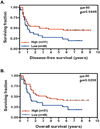Molecular cross-talk between members of distinct families of selenium containing proteins
- PMID: 24395536
- PMCID: PMC3910288
- DOI: 10.1002/mnfr.201300543
Molecular cross-talk between members of distinct families of selenium containing proteins
Abstract
Dietary intake of selenium has been associated with reduced risk of several cancer types, and this is likely due to its role as a specific constituent of selenium containing proteins. One of these, selenium-binding protein 1 (SBP1), is a protein of unknown function that has been shown to be reduced in tumors of diverse tissue types as compared to the corresponding normal tissue. More importantly, SBP1 has also been reported to be a predictor of clinical outcome. Levels of SBP1 are inversely associated with the levels of another protein representative of a different class of selenoproteins, glutathione peroxidase1 (GPx-1). GPx-1 is an anti-oxidant, selenocysteine containing enzyme implicated in several diseases, including cancer, due to the association of specific alleles with disease risk. The relationship between SBP1 and GPx-1 represents a unique example of a molecular interaction between selenium containing proteins with a likely significant impact on human health and disease.
Keywords: Cancer; Clinical outcome; Glutathione peroxidase; Selenium-binding protein 1.
© 2013 WILEY-VCH Verlag GmbH & Co. KGaA, Weinheim.
Conflict of interest statement
Potential conflict of interest statement: The authors declare that there are no conflicts of interest.
Figures

Similar articles
-
Functional and physical interaction between the selenium-binding protein 1 (SBP1) and the glutathione peroxidase 1 selenoprotein.Carcinogenesis. 2010 Aug;31(8):1360-6. doi: 10.1093/carcin/bgq114. Epub 2010 Jun 7. Carcinogenesis. 2010. PMID: 20530237 Free PMC article.
-
The subcellular location of selenoproteins and the impact on their function.Nutrients. 2015 May 22;7(5):3938-48. doi: 10.3390/nu7053938. Nutrients. 2015. PMID: 26007340 Free PMC article. Review.
-
Inverse association between glutathione peroxidase activity and both selenium-binding protein 1 levels and Gleason score in human prostate tissue.Prostate. 2012 Jun 15;72(9):1006-12. doi: 10.1002/pros.21506. Epub 2011 Nov 9. Prostate. 2012. PMID: 22072582 Free PMC article.
-
Decreased selenium-binding protein 1 enhances glutathione peroxidase 1 activity and downregulates HIF-1α to promote hepatocellular carcinoma invasiveness.Clin Cancer Res. 2012 Jun 1;18(11):3042-53. doi: 10.1158/1078-0432.CCR-12-0183. Epub 2012 Apr 18. Clin Cancer Res. 2012. PMID: 22512980
-
Selenium-Binding Protein 1 in Human Health and Disease.Int J Mol Sci. 2018 Nov 2;19(11):3437. doi: 10.3390/ijms19113437. Int J Mol Sci. 2018. PMID: 30400135 Free PMC article. Review.
Cited by
-
Quantitative proteomic analysis reveals that anti-cancer effects of selenium-binding protein 1 in vivo are associated with metabolic pathways.PLoS One. 2015 May 14;10(5):e0126285. doi: 10.1371/journal.pone.0126285. eCollection 2015. PLoS One. 2015. PMID: 25974208 Free PMC article.
-
Cell Cycle-Related Gene SPC24: A Novel Potential Diagnostic and Prognostic Biomarker for Laryngeal Squamous Cell Cancer.Biomed Res Int. 2023 Jan 21;2023:1733100. doi: 10.1155/2023/1733100. eCollection 2023. Biomed Res Int. 2023. PMID: 36718148 Free PMC article.
-
Selenoprotein Gene Nomenclature.J Biol Chem. 2016 Nov 11;291(46):24036-24040. doi: 10.1074/jbc.M116.756155. Epub 2016 Sep 19. J Biol Chem. 2016. PMID: 27645994 Free PMC article.
-
Biochemical and biophysical characterization of the selenium-binding and reducing site in Arabidopsis thaliana homologue to mammals selenium-binding protein 1.J Biol Chem. 2014 Nov 14;289(46):31765-31776. doi: 10.1074/jbc.M114.571208. Epub 2014 Oct 1. J Biol Chem. 2014. PMID: 25274629 Free PMC article.
-
Selenoproteins of the Human Prostate: Unusual Properties and Role in Cancer Etiology.Biol Trace Elem Res. 2019 Nov;192(1):51-59. doi: 10.1007/s12011-019-01809-0. Epub 2019 Jul 12. Biol Trace Elem Res. 2019. PMID: 31300958 Free PMC article. Review.
References
-
- Berry MJ, et al. Recognition of UGA as a selenocysteine codon in Type I deiodinase requires sequences in the 3' untranslated region. Nature. 1991;353:273–276. - PubMed
-
- Driscoll DM, Copeland PR. Mechanism and regulation of selenoprotein synthesis. Annu Rev Nutr. 2003;23:17–40. - PubMed
-
- Kryukov GV, et al. Characterization of mammalian selenoproteomes. Science. 2003;300(5624):1439–1443. - PubMed
Publication types
MeSH terms
Substances
Grants and funding
LinkOut - more resources
Full Text Sources
Other Literature Sources
Research Materials
Miscellaneous

